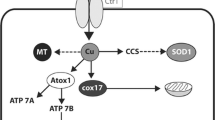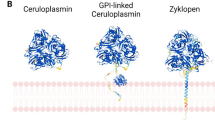Summary
Ceruloplasmin (Cp) is a copper-transport protein with ferric oxidase activity found in high concentrations in the plasma of all vertebrates. Five cell lines (TR-1, TR-M, TR-ST, TM3, and TM4) derived from the testis can be grown in hormone-supplemented serum-free medium. Cp stimulates the growth of four of these five cell lines in serum-free medium. The growth stimulation by Cp is not affected by the addition or deletion of free copper, nor does copper itself elicit any significant growth response. Cp can stimulate growth also in the absence of TF suggesting that it is not acting solely to promote Fe(III)-TF binding. A strong interaction is seen between Cp and high density lipoprotein (HDL), with the presence of either decreasing the growth-promoting activity of the other. It is suggested that these cell lines may provide an ideal system for studying the action of Cp at the cellular level.
Similar content being viewed by others
References
Frieden, G. Caeruloplasmin: A multi-functional metalloprotein of vertebrate plasma. Ciba Foundation symposium, Biological roles of copper. New York: Excerpta Medica; 1980: 93–124.
Ryden, L. Human ceruloplasmin as a polymorphic glycoprotein. Int. J. Protein Res. 3: 131–138; 1971.
Rama, R.; Mareschal, J. C.; Crichton, R. R. The role of ceruloplasmin in iron exchange between ferritin and apotransferrinin vitro. Arch. Int. Physiol. Biochim. 88: B46; 1980.
Gutteridge, J. M. C.; Richmond, R.; Halliwell, B. Oxygen free-radicals and lipid peroxidation: Inhibition by the protein caeruloplasmin. FEBS Lett. 112: 269–272; 1980.
Davis, G. K. Microelement interactions of zinc, copper and iron in mammalian species. Ann. N.Y. Acad. Sci. 355: 130–139; 1980.
Swain, B. K.; Talukder, G.; Sharma, A. Genetic variations in serum proteins in relation to diseases. Med. Biol. 58: 246–263; 1980.
Cass, A. E. G.; Hill, H. A. O. Copper proteins and copper enzymes. Ciba Foundation symposium, Biological roles of copper. New York: Excerpta Medica; 1980: 71–91.
McMurray, C. H. Copper deficiency in ruminants. Ciba Foundation symposium, Biological roles of copper. New York: Excerpta Medica; 1980: 183–207.
Danks, D. M. Copper deficiency in humans. Ciba Foundation symposium, Biological roles of copper. New York: Excerpta Medica; 1980: 209–225.
Mather, J. P.; Perez-Infante, V.; Zhuang, L-Z.; Phillips, D. M. Culture of testicular cells in hormone-supplemented serum-free medium. Ann. N. Y. Acad. Sci. 383: 44–68; 1982.
Mather, J. P. Establishment and characterization of two distinct mouse testicular epithelial cell lines. Biol. Reprod. 23: 243–251; 1980.
Wright, W. W.; Musto, N. A.; Mather, J. P.; Bardin, C. W. Sertoli cells secrete both testis-specific and serum proteins. Proc. Natl. Acad. Sci. USA 78: 7565–7569; 1981.
Mareschal, J. C.; Rama, R.; Crichton, R. R. The role of ceruloplasmin in Fe(III)-transferrin formationin vitro. FEBS Lett. 110: 268–270; 1980.
Linder, M. C.; Moor, J. R. Plasma ceruloplasmin: Evidence for its presence in and uptake by heart and other organs of the rat. Biochim. Biophys. Acta 499: 329–336; 1977.
Mather, J. P.; Sato, G. H. The growth of mouse melanoma cells in hormone-supplemented serum-free medium. Exp. Cell Res. 120: 191–200; 1979.
Perez-Infante, V.; Mather, J. P. The role of transferrin in the growth of testicular cell lines in serum-free medium. Exp. Cell. Res. In press.
Klevay, L. M. Interactions of copper and zinc in cardiovascular disease. Ann. N.Y. Acad. Sci. 355: 140–151; 1980.
Hochstein, P.; Kumar, K. S.; Forman, S. J. Lipid peroxidation and the cytotoxicity of copper. Ann. N. Y. Acad. Sci. 355: 240–248; 1980.
Harris, E. D.; Rayton, J. K.; Balthrop, J. E.; DiSilvestro, R. A.; Garcia-de-Quevedo, M. Copper and the synthesis of elastin and collagen. Ciba Foundation symposium, Biological roles of copper. New York: Excerpta Medica; 1980: 163–182.
Barnes, D.; Sato, G. Methods for growth of cultured cells in serum-free medium. Anal. Biochem. 102: 255–269; 1980.
Schwartz, E.; Bienkowski, R. S.; Coltoff-Schiller, B.; Goldfischer, S.; Blumenfeld, O. O. Changes in the components of extracellular matrix and in growth properties of cultured aortic smooth muscle cells upon ascorbate feeding. J. Cell Biol. 92: 462–470; 1982.
Author information
Authors and Affiliations
Additional information
Presented in the symposium on Plant and Animal Physiology in Vitro at the 33rd Annual Meeting of the Tissue Culture Association, San Diego, California, June 6–10, 1982.
This work was supported by NIH P50 Grant HO-13541. I am grateful to Ms. Florence Kaczorowski for her expert technical assistance.
This symposium was supported in part by the following organizations: Bellco Glass, Inc., California Branch of the Tissue Culture Association, Collaborative Research, Hana Media, Hybridtech, K C Biological, Inc., and Millipore Corporation.
Rights and permissions
About this article
Cite this article
Mather, J.P. Ceruloplasmin, a copper-transport protein, can act as a growth promoter for some cell lines in serum-free medium. In Vitro Cell.Dev.Biol.-Plant 18, 990–996 (1982). https://doi.org/10.1007/BF02796373
Received:
Accepted:
Issue Date:
DOI: https://doi.org/10.1007/BF02796373




